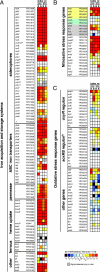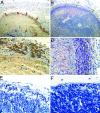Adaptive response of Yersinia pestis to extracellular effectors of innate immunity during bubonic plague
- PMID: 16864791
- PMCID: PMC1518801
- DOI: 10.1073/pnas.0601182103
Adaptive response of Yersinia pestis to extracellular effectors of innate immunity during bubonic plague
Abstract
Yersinia pestis causes bubonic plague, characterized by an enlarged, painful lymph node, termed a bubo, that develops after bacterial dissemination from a fleabite site. In susceptible animals, the bacteria rapidly escape containment in the lymph node, spread systemically through the blood, and produce fatal sepsis. The fulminant progression of disease has been largely ascribed to the ability of Y. pestis to avoid phagocytosis and exposure to antimicrobial effectors of innate immunity. In vivo microarray analysis of Y. pestis gene expression, however, revealed an adaptive response to nitric oxide (NO)-derived reactive nitrogen species and to iron limitation in the extracellular environment of the bubo. Polymorphonuclear neutrophils recruited to the infected lymph node expressed abundant inducible NO synthase, and several Y. pestis homologs of genes involved in the protective response to reactive nitrogen species were up-regulated in the bubo. Mutation of one of these genes, which encodes the Hmp flavohemoglobin that detoxifies NO, attenuated virulence. Thus, the ability of Y. pestis to destroy immune cells and remain extracellular in the bubo appears to limit exposure to some but not all innate immune effectors. High NO levels induced during plague may also influence the developing adaptive immune response and contribute to septic shock.
Conflict of interest statement
Conflict of interest statement: No conflicts declared.
Figures




References
-
- Navarro L., Alto N. M., Dixon J. E. Curr. Opin. Microbiol. 2005;8:21–27. - PubMed
Publication types
MeSH terms
Substances
Associated data
- Actions
Grants and funding
LinkOut - more resources
Full Text Sources
Other Literature Sources
Medical
Molecular Biology Databases

